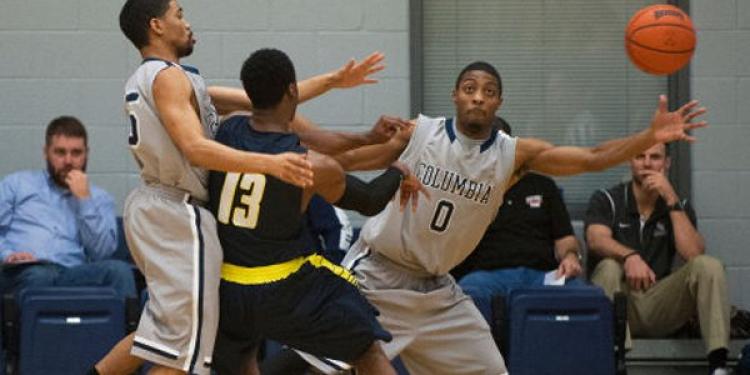College Basketball The Amateurs You Can Gamble Upon
Posted: July 16, 2014
Updated: October 4, 2017

College basketball is one of the few amateur sports in the US you can legally wager upon and it draws billions of dollars in wagers each year.
College Basketball has a following unlike any other amateur sport, the media attention alone singles it out as something apart, something different, and it is not just because the game is a fast paced, exciting thrill ride of high scores between players who will, at the top of their game, soon be gracing the courts of the prestigious NBA. One of the main reasons that college basketball is so popular is because you can wager upon it.
This might seem a tad contrary to American gambling laws that tend to center around betting only being permissible on professional sports rather than amateur ones, but college basketball has long been an exception and despite Sen. John McCain's efforts back in 2001 to have this stopped all he achieved was the horse trading away of people's ability to bet on the Olympics. College football and basketball represent 40% of Nevada's betting handle, so go figure.
With college basketball already so popular in the United States the rise of online sportsbooks in the US and beyond has allowed a vast new market of gamblers to wager on this exciting sport and to follow all the news on sites like Bet365. There isn't an aspect of the game they don't cover in vast detail giving the discerning bettor all the information they require to make a apt decision when placing a wager, whichever team they might be actually backing.
Of course college basketball hasn't arrived in a vacuum and has never been, as the unfamiliar might assume, merely a warm-up act for the NBA. College basketball has a history that stretches back into the past century and beyond, back to its very conception in 1891. Designed by James Naismith as a way to keep athletes fit during winter without risk of injury the first game we would recognize as basketball occurred December 21st of that year.
Of course the rules were slightly different all those years ago and it is often argued that the gambling news would record the 1896 game between Chicago and Iowa as the first proper game of basketball because both teams used five players per side, but then people argue that wasn't a true college game despite the Iowa team comprising of Iowa students they weren't representing Iowa university per se. People who argue this point at a game between Yale and Penn in 1897.
But whatever your view of when it began it is agreed that by 1900 college basketball had spread across the country and gained a popularity amongst coaching staff for its cardio workout in a non-contact environment. The Summer Olympics of 1904 was the first tournament that featured just college teams, albeit only as a demonstration sport, and thereafter there were various competitions held ranging from the Amateur Athletic Union's national championship to the National Intercollegiate Basketball Tournament but these had their issues.
In 1937 the NAIA put forward a national collegiate championship but this was quickly eclipsed by the National Invitation Tournament (NIT) just a year later which saw six teams in Madison Square Garden competing for the win. Then, in what now seems like a logical progression towards better organization, the National Collegiate Athletic Association (NCAA) implemented what we would now recognize as the inter-college championship that we know and love.
One of the secrets behind the NCAA's success is the almost constant expansion of the field of teams involved growing from 25 to 32 in 1975, to 48 in 1980 and then 64 just five years later with a range of venues that approximate a third of the teams involved distributing where people can go and see a college game far more evenly across the country. This expansion of accessibility shouldn't be under-estimated as it is this that has given rise to the NCAA being a tourney to wager upon.
In 2011 the field was expanded further to 68 teams and as the early rounds were juggled to make room for the extra teams the amount of money wagered on college ball rose too. The arguments over the exact figure wagered world wide on college basketball is ongoing with $289 million being wagered legally on March Madness, not no accurate figures for the off-shore (less legal in the states) betting amounts.
It's estimated that world wide perhaps $12bn is bet on college basketball each year and if that sounds excessive one only has to look to the internet and it's online sportsbooks in the US and beyond to realize the limits on the sports gambling market have been lifted. Sites like Bet365 offer the chance for people way beyond the continental United States to enjoy a flutter on this excellent example of amateur sportsmen displaying their amazing skills.
Read more about basketball and betting on it.
College Basketball has a following unlike any other amateur sport, the media attention alone singles it out as something apart, something different, and it is not just because the game is a fast paced, exciting thrill ride of high scores between players who will, at the top of their game, soon be gracing the courts of the prestigious NBA. One of the main reasons that college basketball is so popular is because you can wager upon it.
This might seem a tad contrary to American gambling laws that tend to center around betting only being permissible on professional sports rather than amateur ones, but college basketball has long been an exception and despite Sen. John McCain's efforts back in 2001 to have this stopped all he achieved was the horse trading away of people's ability to bet on the Olympics. College football and basketball represent 40% of Nevada's betting handle, so go figure.
With college basketball already so popular in the United States the rise of online sportsbooks in the US and beyond has allowed a vast new market of gamblers to wager on this exciting sport and to follow all the news on sites like Bet365. There isn't an aspect of the game they don't cover in vast detail giving the discerning bettor all the information they require to make a apt decision when placing a wager, whichever team they might be actually backing.
Of course college basketball hasn't arrived in a vacuum and has never been, as the unfamiliar might assume, merely a warm-up act for the NBA. College basketball has a history that stretches back into the past century and beyond, back to its very conception in 1891. Designed by James Naismith as a way to keep athletes fit during winter without risk of injury the first game we would recognize as basketball occurred December 21st of that year.
College Ball Breaks Out
College Basketball Not A Warm UpThe place was the Springfield College in Massachusetts and within a couple of years this innovative sport has spread to other college campuses. The first inter-entity game is reputed to have been played in 1893 between Vanderbilt University and a team from the local YMCA in Nashville. But it would be another couple of years later in 1895 that two colleges would play match. Hamline University played Minnesota A&M on February 9th with the latter being victorious.
• Online sportsbooks in the US record $289 million
• Expansion key to success
• March Madness brings in the crowds
Of course the rules were slightly different all those years ago and it is often argued that the gambling news would record the 1896 game between Chicago and Iowa as the first proper game of basketball because both teams used five players per side, but then people argue that wasn't a true college game despite the Iowa team comprising of Iowa students they weren't representing Iowa university per se. People who argue this point at a game between Yale and Penn in 1897.
But whatever your view of when it began it is agreed that by 1900 college basketball had spread across the country and gained a popularity amongst coaching staff for its cardio workout in a non-contact environment. The Summer Olympics of 1904 was the first tournament that featured just college teams, albeit only as a demonstration sport, and thereafter there were various competitions held ranging from the Amateur Athletic Union's national championship to the National Intercollegiate Basketball Tournament but these had their issues.
In 1937 the NAIA put forward a national collegiate championship but this was quickly eclipsed by the National Invitation Tournament (NIT) just a year later which saw six teams in Madison Square Garden competing for the win. Then, in what now seems like a logical progression towards better organization, the National Collegiate Athletic Association (NCAA) implemented what we would now recognize as the inter-college championship that we know and love.
Scandals Of 1951 Bruise NIT
The popularity of the tournament stemmed from the fact it varied its location letting more fans see the games than the NIT's New York centered tourney and eventually around 1949/50 the NCAA declared no team could play in both competitions. This might have meant the smaller less prestigious NCAA would have lost out but the point shaving scandals of 1951 pretty much ended the NIT's run of luck and the NCAA took the dominant position it still enjoys today.One of the secrets behind the NCAA's success is the almost constant expansion of the field of teams involved growing from 25 to 32 in 1975, to 48 in 1980 and then 64 just five years later with a range of venues that approximate a third of the teams involved distributing where people can go and see a college game far more evenly across the country. This expansion of accessibility shouldn't be under-estimated as it is this that has given rise to the NCAA being a tourney to wager upon.
In 2011 the field was expanded further to 68 teams and as the early rounds were juggled to make room for the extra teams the amount of money wagered on college ball rose too. The arguments over the exact figure wagered world wide on college basketball is ongoing with $289 million being wagered legally on March Madness, not no accurate figures for the off-shore (less legal in the states) betting amounts.
It's estimated that world wide perhaps $12bn is bet on college basketball each year and if that sounds excessive one only has to look to the internet and it's online sportsbooks in the US and beyond to realize the limits on the sports gambling market have been lifted. Sites like Bet365 offer the chance for people way beyond the continental United States to enjoy a flutter on this excellent example of amateur sportsmen displaying their amazing skills.
Read more about basketball and betting on it.
Related content
Subscribe
0 Comments












